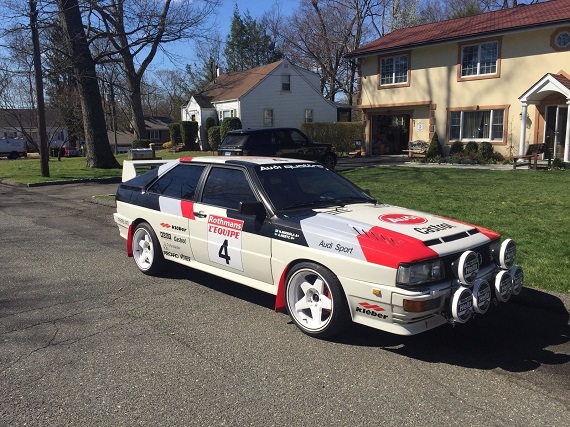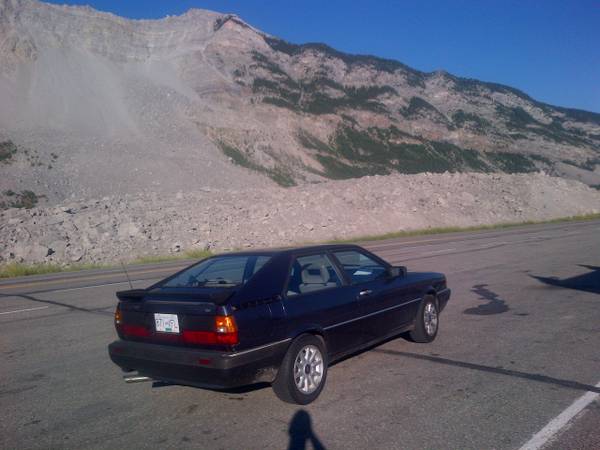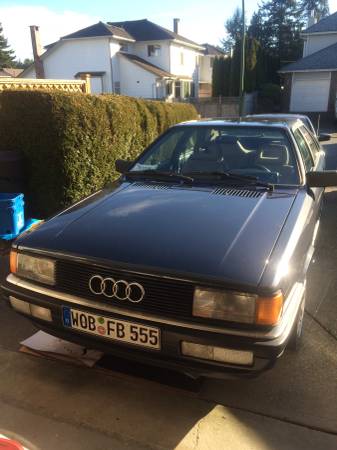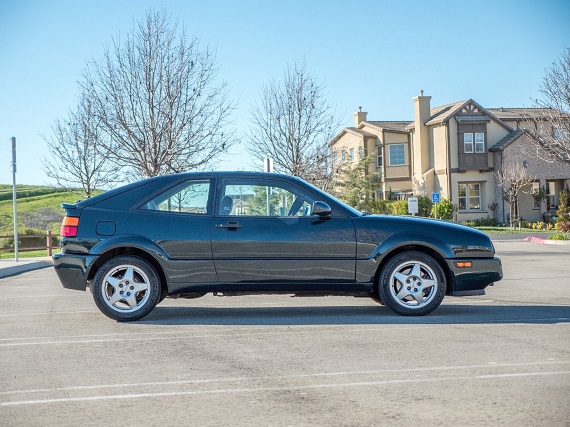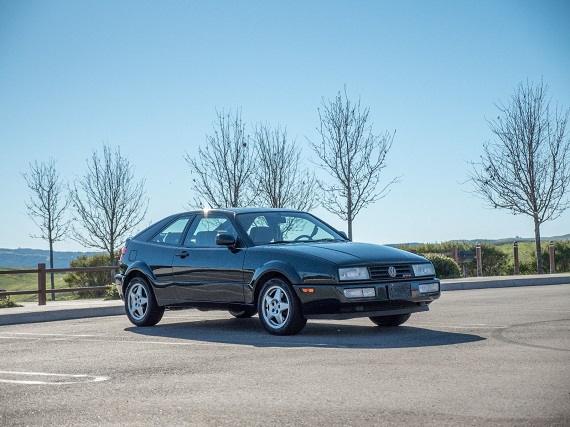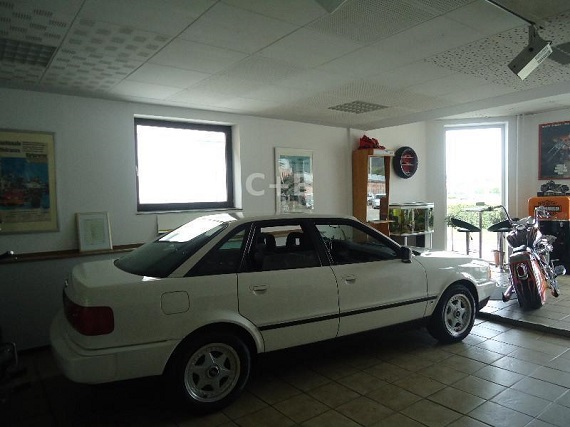In general I like to reserve the Motorsports Monday posts for actual track-flavored cars, but occasionally one comes along that is worth a look even if it’s more of a poseur than pole position. Of course calling any original Quattro a poseur isn’t particularly fair. Out of the box these cars were effectively Group A race cars with some luxury goods fit to them. But the owner of this particular Quattro took the next step in their “restoration” of this 1984 car, modifying the boxflared wonder to look like its fire-spitting WRC brethren. Does it pull it off?
Tag: Speedline
The flexibility of Audi’s B2 platform and the huge number of engine choices that manage to fit under the hood make it a natural choice for swaps. Most popular are the all-wheel drive quattros, but the Coupe GT models are also well built, hugely capable cars that react pretty well to increases in power. And just about every period Volkswagen/Audi motor has made it under the hood of the Coupe GT; from 10 to 32 valves, rev-happy DOHC 16Vs and turbocharged inline-5s to narrow-angle VR6s and even the 4.2 V8s. But this car caught my attention because of the very unusual choice of mill to squeeze juice from. This no-spark Coupe GT has a tuned and turned up 2.0 inline-5 turbo diesel:
CLICK FOR DETAILS: 1986 Audi Coupe GT Turbo Diesel on Vancouver Craigslist
Comments closedWe have a tendency to look at older cars through rose-colored glasses. Today, by all accounts, the Corrado SLC is a modern classic – but was it always so? In fact, if we go back to the original tests of the cars, as with most Volkswagen products it wasn’t the fastest, quickest, best turning or braking. It didn’t turn the fastest lap times and yet was usually the most expensive. As such, in comparisons like Car and Driver’s 1992 Sport Coupe comparison, the Corrado finished only mid-pack. But as with other Volkswagen and Audi products, there was an intangible element to the Corrado that made it somehow more appealing than the competition.
By 1992, the supercharged Corrado G60 was underpowered compared to the competition given its relatively high weight. Volkswagen solved the problem with the introduction of the awesome narrow-angle VR6 motor, rated at 178 horsepower and 177 lb.ft of torque. New wheels mimicked the design of the of the outgoing 1991 BBS wheels on the G60, but were subtly different; underneath hid now 5 bolts and a redesigned suspension, brakes and electronic traction control system. Subtle changes were new clear signals and a re-sculpted hood, along with new nomenclature – the VR6 model was now dubbed the SLC. Further changes were rolled out in 1993; a change of wheels again to the more purposeful 15″ x 6.5″ Speedline 5-spoke design was most notable outside, while inside a revised dashboard had mostly new and more upscale switches, dials and gauges. A fair amount of the 1993-1994 Corrado SLCs were shipped fully loaded, now with a price a staggering $10,000 more than the 1990 base price at a lofty $28,000. That meant few sold, but even though by the numbers these Corrados weren’t the best deal, much like the contemporary Porsche 968 the SLC proved more than the sum of its parts. Even a decade ago some like Richard Hammond from Top Gear were declaring the still fairly new Corrado a future classic, but more recently established collector organization Hemmings tipped the Corrado as a great potential collector. Great! Now, where to find a nice one? That’s a larger problem; the Corrado was so expensive that few were sold here, with low thousand numbers in each 1993 and 1994 production which would be the last year of offer in the U.S.. We’ve got quite a great example to feature today, though:
CLICK FOR DETAILS: 1993 Volkswagen Corrado SLC on eBay
4 CommentsFrom yesterday’s end of the run B2 Audi 90, today we have another special feature on a unique Audi. While the B3 heavily revised the safety, aerodynamics, comfort and luxury for the small Audi range, weight went up and power was effectively the same, meaning that the B3 was at a distinct performance disadvantage to the natural rival BMW. Audi did increase the amount of power that the B3 quattros had at their disposal with the introduction of the 7A 20V motor in 1990, but the twin-cam inline-5 wasn’t available in front drive Audis which sold in greater number. That gulf grew wider as BMW upped the power again with the new E36 chassis, now with the best part of 190 horsepower available in the 325i. To answer the competition, Audi heavily revised both its large and small chassis in for the 1991 and 1992 model years. The C4 model was introduced late in 1990 in Europe, and while Audi did away with the 200 model the new S4 ostensibly replaced it with even more sport. But the 100 saw massive changes too, with the introduction of automatic transmissions to the quattro range widening the appeal of the model. Though the V8 quattro had offered that option previously, it was a much more expensive model and the 100 was also available in Avant form. But the big change was under the hood, where a AAH 12 valve single cam 2.8 liter V6 replaced the previous NG/NF 2.3 naturally aspirated inline-5 and MC1/2 2.2 turbocharged inline-5 power units of the 100 quattro and front-drive and 200 Turbo front wheel drive models, respectively.
In the small chassis, Audi continued to offer two different chassis levels for the newly introduced for 1992 B4. Carrying over from the C4 range was the same 172 horsepower 2.8 V6, powering either all four wheels or the front wheels only. Few mechanical changes were made to the quattro models versus earlier inline-5 models, but the front drivers received more refinement from a trailing arm torsion beam axle instead of the previous Panhard rod design. Outside, new front and rear fascia was mostly expressed by integrating the hood and grill to match the C4 design. Fender flares increased, new contoured hoods offered more character, and different bumper covers updated the look slightly. New wheel designs were also incorporated into the B4 lineup, with 10 spoke Speedline-made wheels being standard and optional Ronal “Sport” 5-spoke wheels, both in a slightly greater 37mm offset as opposed to the 45mm offset of early B3 models (with the exception of the Coupe). There were plenty of other minor changes inside and out that added up to a very different and more refined feel versus the earlier B3. But Audi needed to provide some time for U.S. dealers to relaunch the new 90 model range. So, while in 1991 you could buy either a 90 quattro 20V or 80 quattro, in 1992 there was only a 80 model available – no 90s were sold. This coincided with the lowest sales figures for the small chassis Audi had recorded. The new 90 would launch here in late 1992 as a 1993 model in both quattro and FrontTrak form. And to help promote the new model, Audi brought over a few pre-production models, one of which we have here:
Email Seller: 1992 Audi 90S on German Cars For Sale Blog
4 CommentsBack in October I took a look at a Ruf Cabriolet. Originally listed as a BTR3, the listing has been corrected to refer to the car as a BTR 3.4. Last time around one of our knowledgeable readers commented that there were injection differences between the two. There’s also been a pretty substantial price drop of $40,000 to a still nose bleed-worthy $200,000. Is it likely to find a home this time around?

